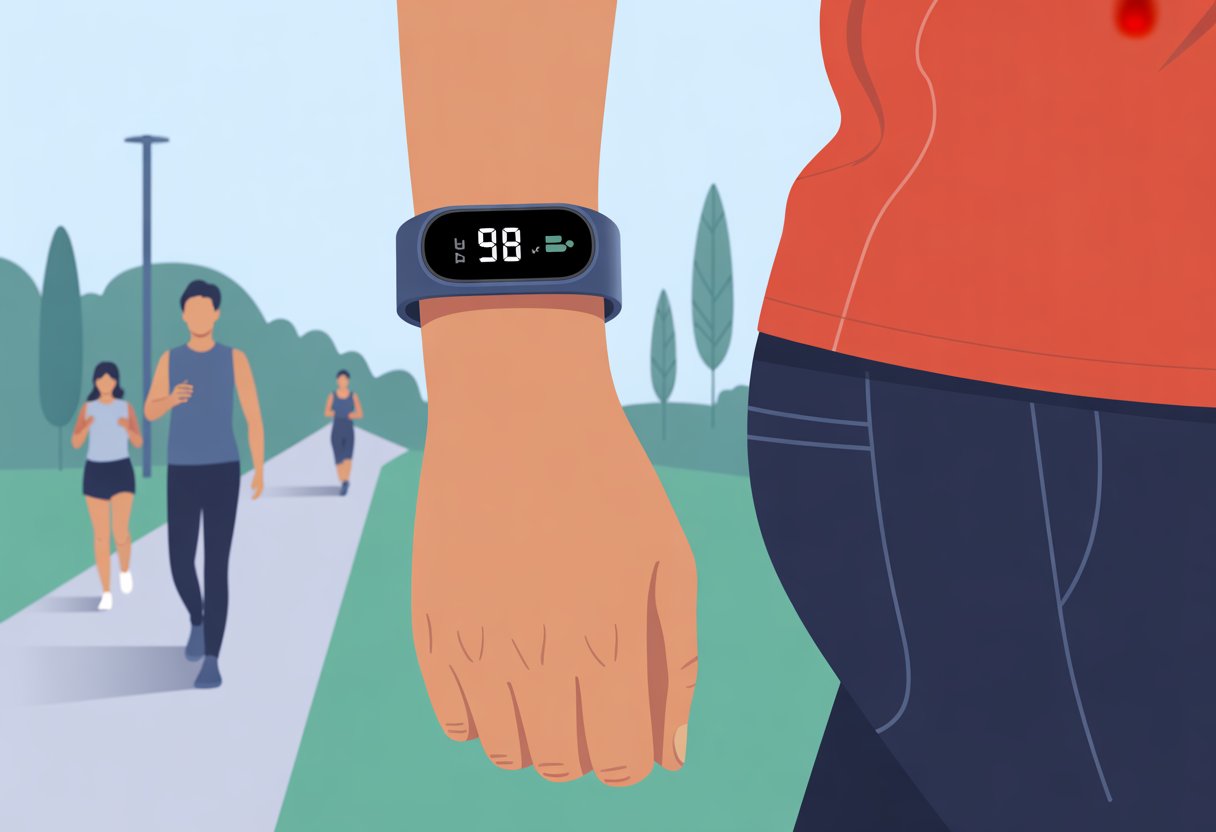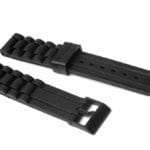Let’s be real—most of us aren’t prepping for a marathon anytime soon. We just want to know if wandering to the fridge actually does us any good. With a fitness tracker, we can easily keep tabs on every step, whether we’re strutting down the hallway or getting lost in the grocery store. It’s basically a tiny, judgmental robot on our wrist, quietly rooting for us—or, okay, sometimes shaming us for being a bit lazy.

Fitness trackers make step counting a breeze. They’ve got sensors like accelerometers and gyroscopes that pick up on movement and try to figure out if we’re walking, skipping, or dodging Lego bricks barefoot in the living room.
Ever wondered how many steps it takes to chase your dog around the yard? Now you’ll know.
We don’t have to guess about our activity anymore. A fitness tracker shows our step count as it happens, which can nudge us to take a few more laps around the kitchen or at least walk to the mailbox.
Whether we’re actually trying to get fit or just want to one-up our friends in a step challenge, figuring out how to use this thing could even be a little fun.
What Is a Fitness Tracker and How Does Step Counting Work?
Our wrists aren’t just for watches anymore. These days, they double as personal step detectives, tracking how much we move and, let’s be honest, gently shaming us into doing a bit more.
Let’s look at what these gadgets actually do and how they make sense of all our wiggles, hops, and shuffles.
Understanding the Basics
A fitness tracker is a small gadget we wear to keep tabs on movement, exercise, or even sleep. It’s like a tiny coach that never yells but always keeps score.
Most of us use a fitness tracker to count steps because, well, stepping means moving, and moving is usually good for us. When we wear one, it uses built-in sensors to count every step—even if we’re just raiding the fridge for cold pizza.
This process is called step counting.
Activity trackers usually sync up with our phones. That means we get colorful graphs, daily goals, and sometimes even sparkly badges (who doesn’t want a gold star for walking the dog?).
How Pedometers Differ From Modern Trackers
Pedometers started it all. These were simple gadgets you’d clip on your hip, and they counted steps with a little mechanical arm that bounced with each step.
If your grandma had one, she probably loved the “click-clack” sound.
Modern trackers are way more advanced. They don’t just count steps—they track heart rate, record sleep, estimate calories burned, and sometimes even count how many flights of stairs we’ve climbed.
Now, we don’t have to clip anything to our waistband. These devices live on our wrist, in a pocket, or even in a shoe.
They’re more accurate and give us way more info than old-school pedometers ever could.
The Magic of Activity Tracking Sensors
Most fitness trackers use accelerometers. These super-sensitive sensors pick up when we move, shake, walk, or even dance badly in our living room.
An accelerometer measures changes in speed and direction.
When our foot hits the ground, the device senses the sudden stop (that’s deceleration). The tracker’s “brain” decides, “Yep, that was a step!” It’s a lot smarter than just counting bounces.
If you want to geek out, here’s more on how smartwatches count your steps.
Some trackers use other sensors too, like gyroscopes or heart rate monitors. These extra tools help us get a fuller picture of our activity—and maybe explain why our step count jumps when we trip over the cat.
Getting Started: Setting Up Your Device
Getting a fitness tracker ready isn’t rocket science. We just connect it wirelessly, set our step goals, and grab a couple of handy apps.
That way, every step counts—whether we’re power-walking or just sneaking to the fridge for leftovers.
Syncing Your Tracker With a Wireless Connection
First, let’s grab our tracker and pretend we’re spies syncing a secret gadget. Most trackers use Bluetooth to connect to our phone or tablet.
We need Bluetooth turned on—don’t worry, it’s painless.
Download the companion app for your tracker. Fitbit and Strava are both popular, and they make syncing simple.
Setting up usually means tapping “Pair Device” or “Add Tracker” in the app. If your tracker blinks or vibrates, it’s basically saying, “Nice job!”
Keep your device close to your phone during syncing. Wireless signals hate going through walls or hiding behind giant sofas.
If you want a quick visual, here’s a reference guide. Syncing sends all our steps and activity into the app, so our stats are always up to date.
Customizing Your Activity Level and Step Goal
Next up: let’s customize our step goal to fit our own lifestyle. During setup, the app asks about our activity level.
No judgment here—just be honest if your steps come mostly from pacing during Zoom calls.
We can set a daily step goal. Fitbit and similar apps suggest 10,000 steps, but we can pick any number that feels right.
Want to brag at family dinners? Set it higher. Just want to out-walk your cat? Start at 3,000.
Customizing our activity level changes the experience. We’ll get nudges if we’re slacking and virtual high-fives when we crush our step goal.
The app tracks our progress, so there’s always a reason to walk a bit more, even if it’s just to the mailbox.
Downloading Helpful Apps Like Fitbit and Strava
We need the right apps to get the most out of our tracker. Fitbit and Strava help us track steps, set goals, and join challenges with friends.
Just search for the app in the App Store or Google Play. Once it’s installed, create an account or sign in if you’re already a member.
Connect your tracker with the app’s step-by-step guide.
Fitbit tracks everything from steps to sleep. Strava is awesome for turning walks into friendly competitions.
These apps make step counting way more fun—it’s almost like a game, but without the secret handshake.
Step Counting 101: Using Your Fitness Tracker
Getting the most from a fitness tracker isn’t just about strapping it on and hoping for the best. We want every step to count—whether we’re chasing the dog, taking the stairs, or sneaking to the fridge for the third time tonight.
Making Every Step Count (Even to the Fridge)
Let’s be honest: sometimes our best walking happens late at night, heading for snacks. Thankfully, most trackers use built-in accelerometers that log every step, no matter where we’re going.
That means grocery shopping, walking to class, or pacing during a phone call all help us hit our daily step goals.
The famous 10,000 steps might sound like a lot, but hitting that number is all about counting every bit of movement. Our tracker doesn’t judge.
If we wiggle, shuffle, or power-walk, these little gadgets add it all up.
The cool part? Steps you take while doing chores or heading to the kitchen totally count.
We get credit for every bit of hustle. Fitness trackers are always watching—so, hey, every trip to the freezer for ice cream is technically part of our step goal.
Curious how it all works? Fitness trackers record steps by picking up repetitive motion patterns with built-in sensors and some clever algorithms.
If you want more details, here’s a simple explanation of how fitness trackers count steps.
Tracking Walking, Running, and Cycling
Not all steps are equal, and our tracker knows it. When we switch from walking to running—or hop on a bike—our tracker figures out how to log the activity and calories.
Usually, we don’t have to set it manually. Most trackers pick up on speed and movement changes by themselves.
Walking and running both boost our step count, but cycling is a little different. Since our feet aren’t pounding the ground, many trackers use special algorithms or just skip counting pedal strokes as “steps.”
Some trackers let us log cycling as its own activity, tracking distance and calories but not steps.
So, that afternoon bike ride is still good for us—it just might not up our step count.
For better accuracy:
- Update activity mode in the app if needed
- Check if your tracker has a cycling mode
- Look over your daily stats after each activity
Understanding Metrics: More Than Just Numbers
It’s tempting to focus only on steps, but a fitness tracker gives us more than just a tally. We also see distance, calories burned, speed, heart rate, and even active minutes.
These numbers help us figure out what parts of the day keep us moving—and which ones glue us to the couch.
Steps get all the glory, but tracking trends over weeks is even more useful. Did we average 10,000 steps this month, or just pace during endless Zoom calls?
Our trackers help us spot lazy patterns and nudge us to get moving. Some devices even buzz to remind us to “move”—usually right when we’re finally comfy.
If you’re new to all these stats, here’s a quick cheat sheet:
| Metric | What It Tells Us |
|---|---|
| Steps | How much we’re moving |
| Distance | How far we travel |
| Calories | Energy we burn |
| Active Minutes | Total time in motion |
Let’s not just count steps. Let’s make the numbers actually mean something—and maybe get us moving a bit more, even if it’s just another trip to the fridge.
If you want to dig deeper, check out this fitness tracker beginner’s guide.
Interpreting Your Step Data
Reading our step data isn’t just about seeing big numbers and celebrating—we need to know what those numbers mean for us.
By looking more closely, we can spot patterns, cheer each other on, and change our routines for better results.
Monitoring Progress Toward Fitness Goals
Let’s be real: hitting our step goals feels pretty great. But before we get there, we need to actually set some goals.
Most adults shoot for somewhere between 7,000 and 10,000 steps a day. That’s just a general range—your needs might be totally different.
If you’re just getting started or dealing with health stuff, a lower target is totally fine.
With a tracker on our wrist, we can check if we’re getting those steps in. Most devices show a progress bar, and some even toss in confetti or a silly dance animation (if only those counted as steps, right?).
Watching that progress build up each day is a reminder that every stroll to the fridge actually matters.
Breaking big goals into bite-sized wins makes things more manageable. For example, try these little challenges:
- Squeeze in 500 extra steps at lunch.
- Pace around while chatting on the phone.
- Add a quick morning walk.
Each small win nudges us closer to our fitness goals. Even if our main exercise is chasing after the ice cream truck, it all adds up.
Analyzing Trends in Daily Steps and Active Time
Let’s channel our inner data detectives for a second. Tracking steps only helps if we actually notice our patterns.
Most trackers display our average step count, busiest days, and even how often we managed to get off the couch.
Looking at our step history in a table or graph is super helpful:
| Day | Steps Taken | Active Minutes |
|---|---|---|
| Monday | 7,050 | 40 |
| Tuesday | 6,113 | 35 |
| Wednesday | 8,828 | 55 |
If our steps drop every weekend, maybe the sofa is winning. If we have “Treadmill Thursday,” those numbers probably spike.
Spotting trends in our active time—not just total steps—shows us which days we’re moving more or less. That way, we can plan something fun to boost those numbers.
Adjusting Your Plan for Better Results
Real progress shows up when we actually change things based on our data. If our daily step count isn’t where we want it, or we’re not seeing much improvement, it might be time to tweak the routine.
We can use our tracker’s insights to mix things up. Maybe we need more morning walks, or perhaps it’s time to try walking meetings at work.
Let’s challenge each other to literally “step up” our game.
If steps alone aren’t cutting it, we could add short bursts of higher-intensity activity. New daily goals or group challenges can give us a little nudge.
Start a leaderboard and suddenly everyone’s trying to out-step each other—kind of fun, honestly.
Checking in with our data helps us avoid falling into a rut and keeps us moving towards our fitness goals—with a little personality and maybe a goofy walk or two along the way.
Beyond Steps: Bonus Metrics to Boost Your Fitness
Step counts are nice, but our trackers have a few extra tricks. There’s more to fitness than just circling the kitchen for the tenth time.
Heart Rate Insights and Monitors
Tracking heart rate isn’t just about bragging at the gym. Most trackers use built-in monitors to check on us all day, even when we’re “resting” on the couch.
This feature shows us how hard we’re working—and keeps tabs on our downtime between workouts (or, let’s be honest, between episodes).
Many trackers show our resting heart rate, which hints at our current health. A lower resting rate usually means our heart’s working efficiently.
Some even estimate VO2 max—basically, how much oxygen your body can use. If you’re into big science words, that one’s for you.
By keeping an eye on our heart rate, we can spot trends, track fitness progress, and maybe realize it’s time to cut back on the triple espressos—or just take a nap.
Calories Burned: Walking vs. Running
Counting steps is fun, but sometimes we just want to know if we’ve “earned” that snack. Trackers estimate calories burned for different activities, like walking or running, by looking at steps, movement intensity, and heart rate.
Running usually burns more calories than walking since it takes more effort and gets our heart pumping. But speed walking or tackling hills can torch calories too. Here’s a quick breakdown:
| Activity | Calories Burned (approx. per hour) |
|---|---|
| Walking | ~200-300 |
| Running | ~400-600 |
Of course, your mileage may vary depending on how badly you want that ice cream truck. The calories feature helps us plan workouts—and maybe dessert—by showing the difference between a stroll and a sprint.
Want details on how trackers estimate all those stats? Check out this review of activity trackers.
Advanced Features of Activity Trackers
Modern trackers do way more than count steps. We can climb, sleep, and even swim our way to better health, all while collecting data right on our wrists.
Let’s dive in—feet first.
Floors Climbed: Taking Step Counting to New Heights
Ever wonder if those stair sprints actually count? Good news—they do!
Most trackers measure floors climbed using barometers that detect altitude changes. So when we huff up the stairs, our device knows we’ve gone vertical.
Tracking how many floors we climb each day gives us a peek at our heart health and overall effort. Some trackers show this in a daily report.
We can even set goals for floors, not just steps. Not all steps are created equal—switching from flat to stairs burns more calories and builds stronger legs.
If you live in a two-story house (or get stuck in a subway without escalators), this feature keeps things interesting. Every trip to the attic now counts double when it comes to bragging rights.
Sleep Monitoring for Nighttime Ninjas
Trackers don’t sleep, even when we do. Using sensors like accelerometers and heart rate monitors, they detect if we’re in deep sleep, light sleep, or just practicing ninja moves in our dreams.
A good tracker breaks our night into blocks of restful and restless time. If we wake up feeling like a zombie, maybe the stats are to blame—not just the pillow.
Many devices give us a sleep score, nudging us to build better bedtime habits (and maybe put the phone down for once).
Some trackers buzz to remind us to head to bed. Others log naps for those of us who take rest seriously.
Next time someone says, “You look tired,” we can reply with the facts: “Actually, I was in deep sleep for 2 hours and 5 minutes, thanks.”
Water Resistance for Fitness Trackers
We’ve all forgotten to take off our trackers before a shower or jumped straight into the pool. These days, most devices come with some level of water resistance.
Terms like “IP68” or “5ATM” pop up a lot, but they mean different things. IP68 handles splashes or a quick dunk, while 5ATM means you can swim laps without worry.
Unless you’re planning to visit Atlantis, it’s still smart to avoid deep dives or hot tubs.
Here’s a quick cheat sheet:
| Water Resistance Rating | What It Means |
|---|---|
| Splash-Resistant | OK for rain or hand washing |
| IP68 | Short swims, shower-proof |
| 5ATM or higher | Swim-proof, pool friendly |
With proper water resistance, we don’t have to panic when it rains or when our swim coach gets extra splashy. Our data—and our dignity—stay safe.
Tips for Accurate Step Counting
To get the most out of our tracker, we need to make sure we’re counting steps as accurately as possible. Step tracking can get thrown off by where we wear our device or how wildly we wave at passing dogs.
Improving Accuracy Through Proper Placement
Where we wear our tracker makes a big difference—kind of like picking the best spot for a sticker. If we strap it onto our less dominant arm, we usually get more accurate results.
That’s because our dominant hand does a lot of waving, snack grabbing, and the occasional jazz hands. All that extra motion can trick trackers into thinking we’re walking when we’re just reaching for the remote.
Most trackers suggest wearing the device snug on the wrist, with the screen facing up. A loose fit makes it slide around, giving us phantom steps we never actually took (unless fidgeting counts as cardio).
If we use a clip-on tracker, we should pop it on our waistband or chest pocket to keep it steady as we move. Double-check the location advice from the manufacturer, since not all trackers have the same preferences.
Understanding Motion Tracking Limitations
Fitness trackers don’t have magic powers—at least, not yet. They rely on little sensors called accelerometers to figure out when we’re actually taking a step.
If you’re pushing a grocery cart, clapping at a concert, or even flapping your arms to scare off geese, your tracker might get totally confused. Not every hand movement means you’re strutting your stuff, though it might think otherwise.
Even our pace and stride play a role. If you walk too slowly or just shuffle around, the tracker might not count those steps at all.
Want to check if your tracker’s working right? Try walking 100 steps and see if the number matches up. If it doesn’t, you might want to recalibrate or see if there’s a software update waiting.
People who use strollers or walkers sometimes miss out on steps, which feels a bit unfair. Maybe just chalk it up as a secret bonus round of hide and seek.
Curious about how these step counters actually figure out movement? Here’s a handy explainer on how step counters work.
- How to connect Bluetooth headphones to a Chromebook Without Summoning Tech Support - December 15, 2025
- Best Fitness Trackers for EMS Workers: Because Your Heart Rate Isn’t the Only Thing Racing - December 15, 2025
- Why do my Bluetooth headphones not skip tracks? Tech tantrums and other musical mysteries - December 14, 2025






